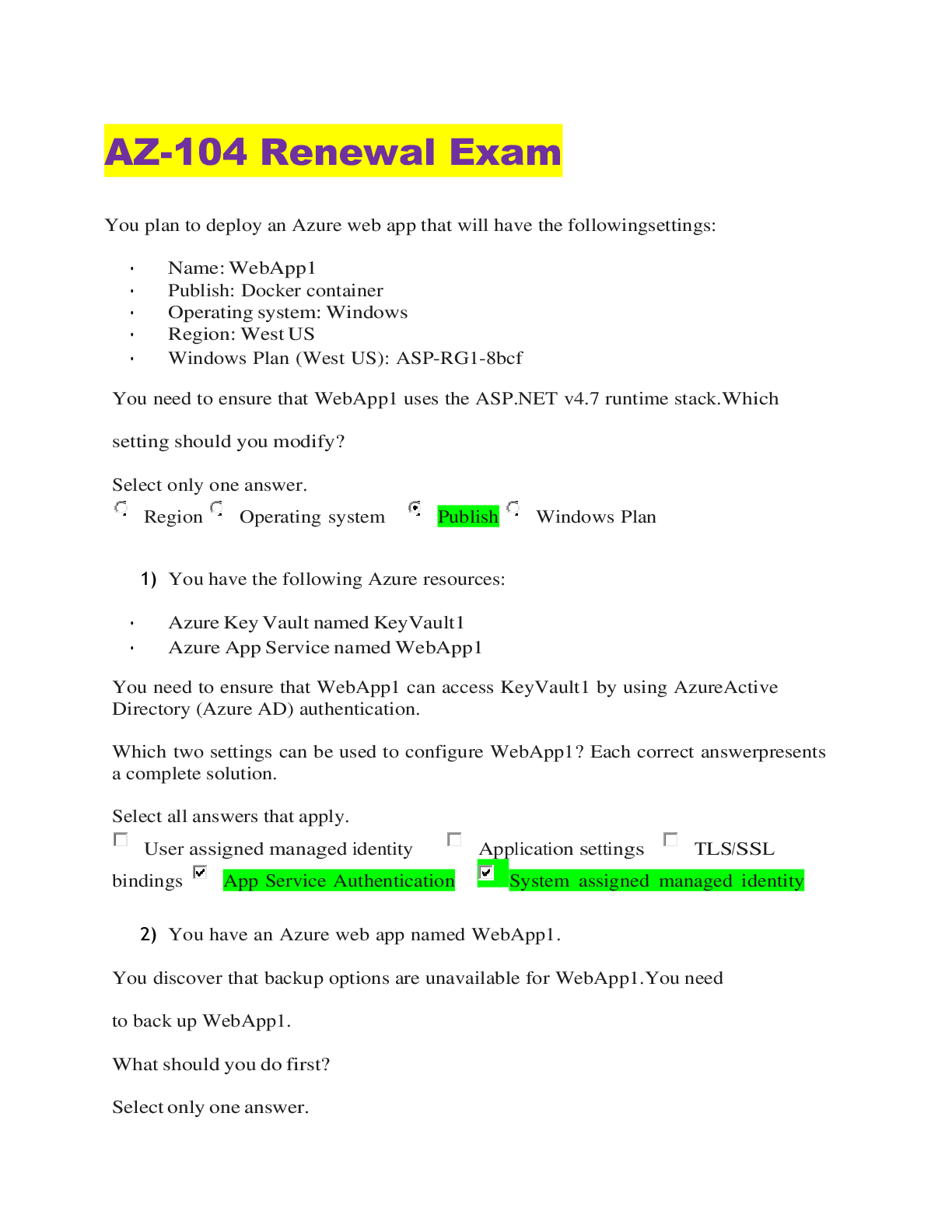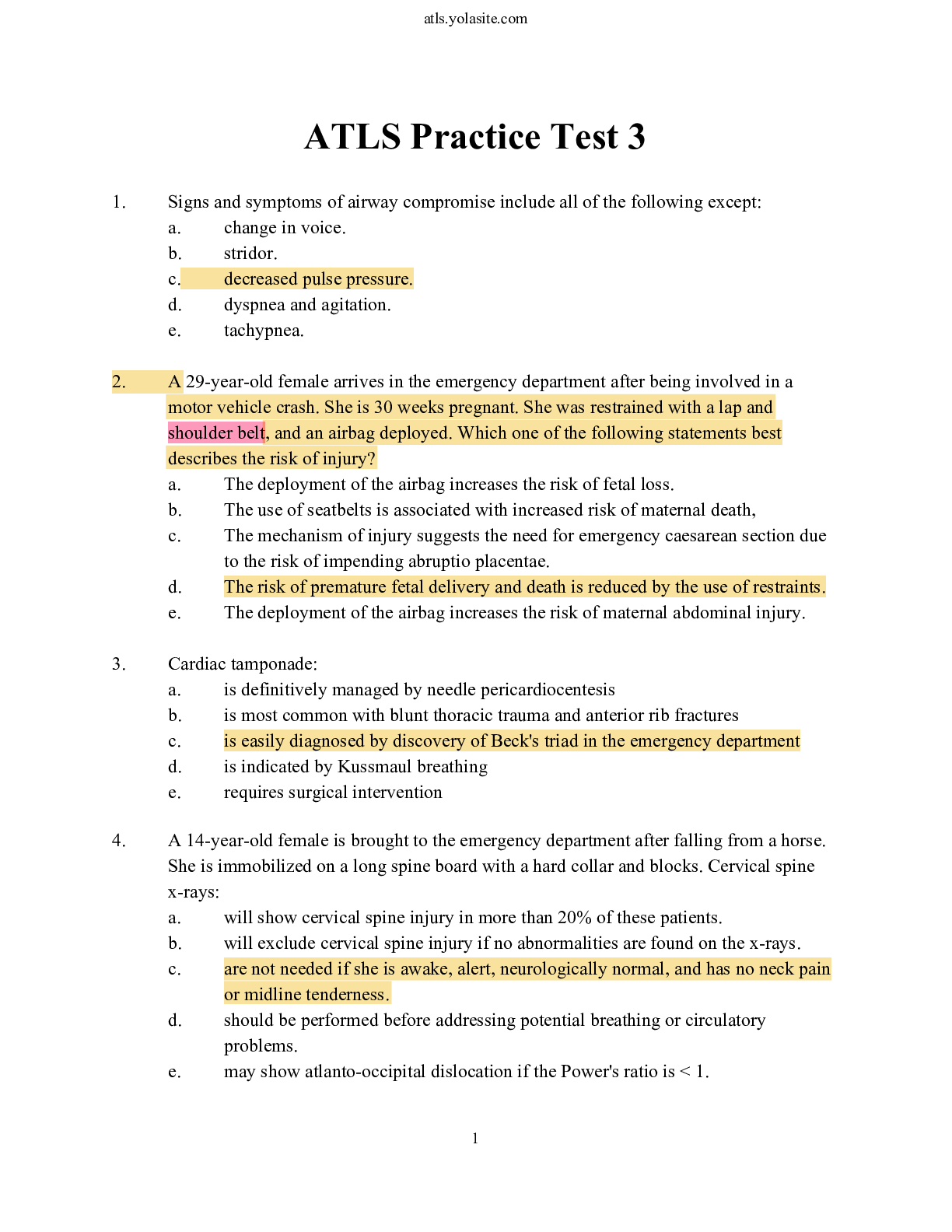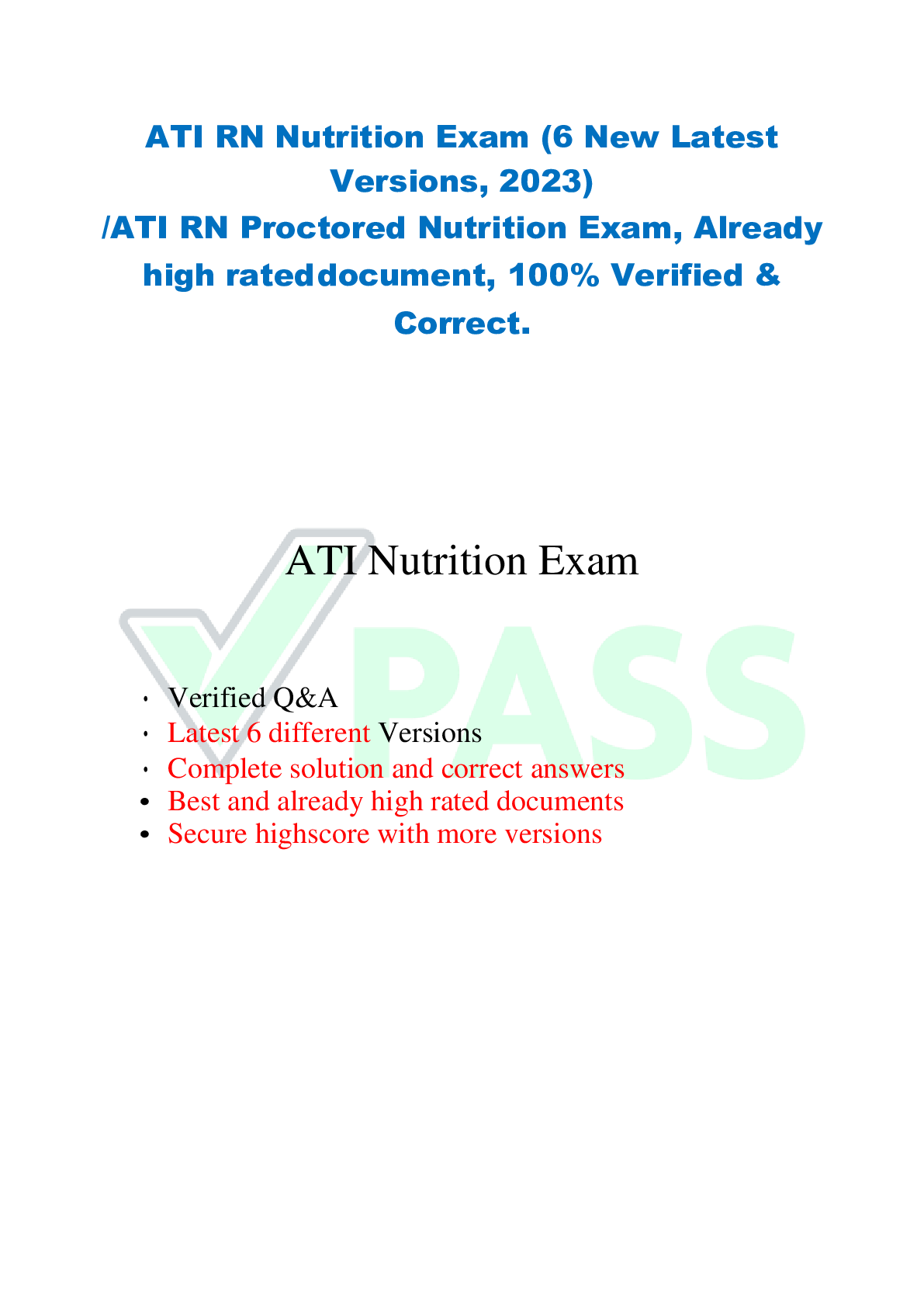Exam 2 Nutrition NR-228 (2022 GRADED A)
Document Content and Description Below
Exam 2 Nutrition NR-228 (2022 GRADED A) Water and minerals are primary components-answer- of body fluids, and each performs other functions as well. Tolerable Upper Intake Level (UL)-answer- ... highest average daily intake level of a nutrient likely to pose no risk of negative health effects Recommended Dietary Allowance (RDA)-answer- average amount of a nutrient considered adequate to meet the needs of all healthy people (98%) Alpha-tocopherol (a-TE)-answer- The most active form of vitamin E in the body RAE means-answer- retinol activity equivalents. vitamin A is the unit of measurement associated with it Vitamins are-answer- organic molecules that perform specific metabolic functions. Vitamins are divided-answer- into water soluble and fat soluble. Solubility of vitamins affects-answer- the processes of their absorption, transportation, and storage in our bodies Water-soluble vitamins are-answer- vitamin C, choline, and the B complex vitamins (thiamin, riboflavin, niacin, folate, pyridoxine [B6], vitamin B12, pantothenic acid, and biotin). What is easily absorbed into blood circulation-answer- Water-soluble vitamins Fat-soluble vitamins are-answer- vitamins A, D, E, and K. Carbohydrates are organic compounds composed of-answer- carbon, hydrogen, and oxygen in the form of simple carbohydrates. There are three sizes of carbohydrates-answer- monosaccharides, disaccharides, and polysaccharides Monosaccharides-answer- glucose, fructose, and galactose Disaccharides-answer- sucrose, maltose, and lactose Polysaccharides-answer- starch, fiber, and glycogen Food carbohydrates are divided into two categories-answer- simple carbohydrates and complex carbohydrates Simple carbohydrates-answer- monosaccharides and disaccharides Complex carbohydrates-answer- polysaccharides, excluding glycogen Dietary Reference Intake (DRI) for carbohydrates-answer- 130 g/day for adults between 19and 30 years of age. Acceptable Macronutrient Distribution Range (AMDR)-answer- 45% to 65% of kcal intake per day as primarily complex carbohydrates. Dietary Guidelines recommends-answer- emphasizing a plant-based diet including fruits, vegetables, cooked dried beans and peas, whole grains, and seeds. Energy circulates in the bloodstream-answer- glucose Carbohydrates-answer- are an abundant food source of energy and dietary fiber Blood glucose levels-answer- are regulated and balanced through hormonal systems. normal range 70- 100 mg per deciliter Hypoglycemia and diabetes mellitus-answer- may occur when these systems cannot regulate glucose within normal levels. Dietary fiber-answer- does not provide energy; it is not digestible by humans. Consuming adequate quantities of soluble and insoluble fiber-answer- has significant health benefits. The DRI for dietary fiber-answer- 25 to 38 g for adult women and men, respectively. Best carbohydrate food energy sources-answer- grains, legumes, and starchy root vegetables. Best dietary fiber sources:-answer- fruits, vegetables, and whole-grain products. Nutrients are lost when-answer- unrefined (whole) grains are refined Dietary Guidelines recommends increased consumption of-answer- complex carbohydrates MyPlate proposes-answer- 6 ounces of grains, 4.5 cups of vegetables, and 2 cups of fruits Triglycerides-answer- provide food functions of energy, palatability, satiety, food processing, and source of nutrients. Triglycerides Physiologic functions-answer- include form of stored energy; organ protection; temperature regulation; and insulation. Phospholipids-answer- are a component of all cell membrane structures; emulsifiers of fluids within of the body; and part of the transport of lipids throughout the body. Sterols-answer- are part of complex regulatory compounds within the body. also known as cholesterol which is a vital part of all cell membrane and nerve tissues; and of building blocks for hormones. Sterols composition-answer- a basic material to make bile; vitamin D; sex hormones; and cells in brain and nerve tissues. including cholesterol, are carbon rings intermeshed with side chains of carbon, hydrogen, and oxygen. Lipids-answer- are organic, composed of carbon, hydrogen, and oxygen. Triglycerides are composed-answer- one glycerol molecule and three fatty acids. Fatty acids may be-answer- saturated, monounsaturated, or polyunsaturated, depending on the number of double bonds. Phospholipids are composed of-answer- one glycerol molecule with only two fatty acids; the third spot contains a phosphate group. All three types of lipids can be manufactured by-answer- the body, except for linolenic and linoleic fatty acids linolenic and linoleic fatty acids-answer- found in triglycerides, which therefore are essential nutrients. Digestion of lipids occurs mainly in the-answer- small intestine; absorption depends on the transportation of lipids through the lymph and blood circulatory systems. Health concerns about dietary fat intake fall into several categories-answer- appropriate energ [Show More]
Last updated: 1 year ago
Preview 1 out of 6 pages
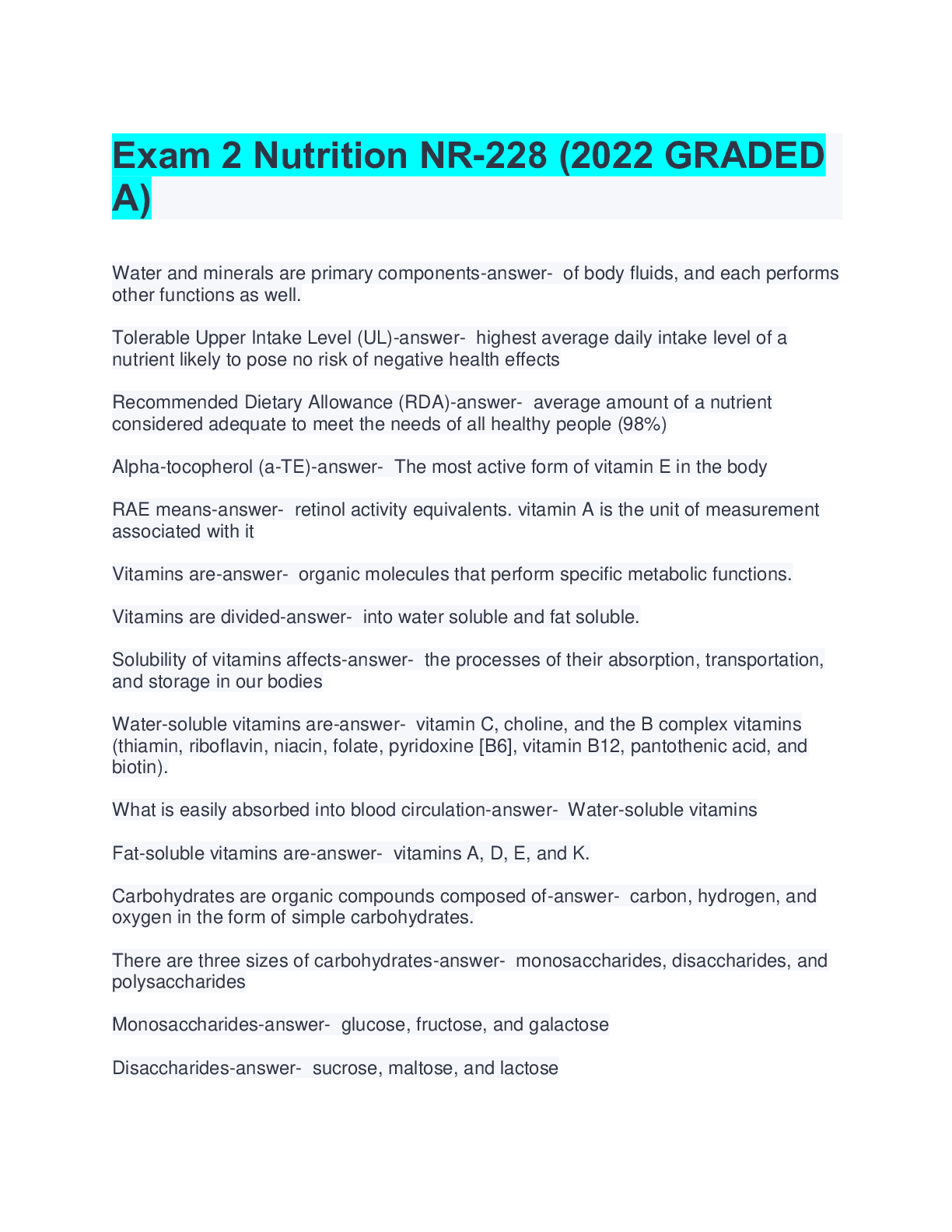
Buy this document to get the full access instantly
Instant Download Access after purchase
Add to cartInstant download
We Accept:

Reviews( 0 )
$12.00
Document information
Connected school, study & course
About the document
Uploaded On
Sep 10, 2022
Number of pages
6
Written in
Additional information
This document has been written for:
Uploaded
Sep 10, 2022
Downloads
0
Views
30


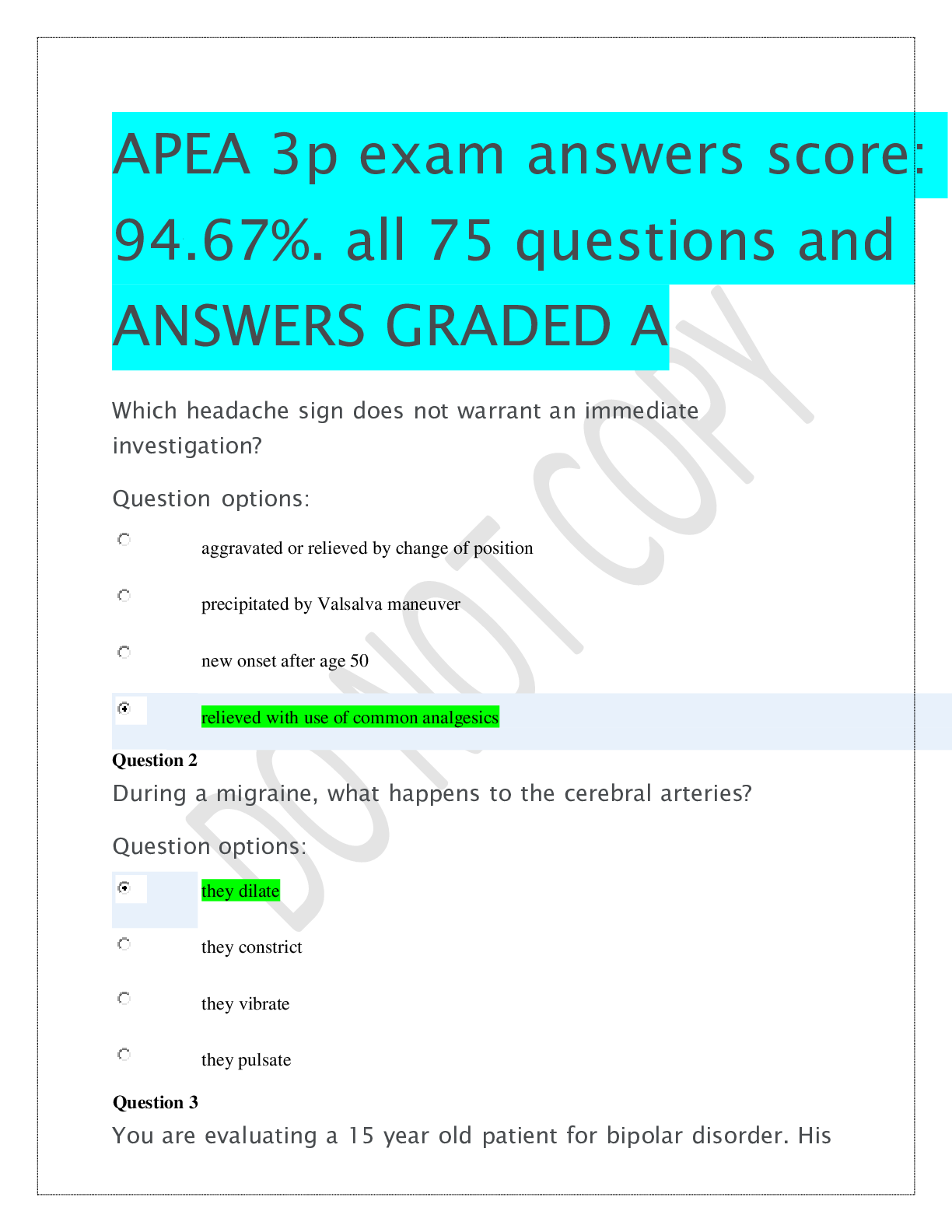


.png)
.png)


